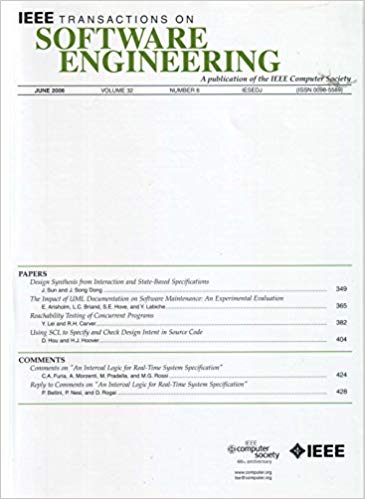FM-PRO:一个特征建模过程
IF 6.5
1区 计算机科学
Q1 COMPUTER SCIENCE, SOFTWARE ENGINEERING
引用次数: 0
摘要
几乎任何软件系统都需要以多种变体存在。当分支或分叉——也就是。克隆和自有——这是简单且廉价的策略,但它们并不能很好地扩展变体的数量。软件platforms-a.k.a。软件产品线——通过在自动化的、工具支持的过程中选择所需的特性,扩展并允许派生变体。然而,产品线很难采用和发展,需要在复杂的代码库中管理特性及其实现的机制。这样的系统可以很容易地拥有数千个具有复杂依赖关系的特性。特征模型已经成为建模和管理特征的最流行的表示法,主要是因为它们具有直观的树状表示法。30多年前,已经出现了数千种依赖于特征模型的技术,包括模型配置、综合、分析和进化技术。然而,尽管有许多成功的案例,组织仍然在努力采用软件产品线,限制了这些技术的有用性。令人惊讶的是,不存在系统化地创建特征模型的建模过程,尽管它们是产品线的主要工件。这给组织带来了挑战,甚至阻碍了产品线的采用。我们提出了FM-PRO,一个设计特征模型的过程。它可以用于产品线的不同采用策略,包括从头创建一个(主动采用)和从现有克隆变体重新设计一个(提取采用)。得到的特征模型可以用于配置、规划、演化、对变量的推理,或者保持对复杂软件平台的总体理解。我们根据经验得出的建模原则系统地设计了这个过程。我们在一个真实的工业案例研究中评估并改进了它,与工业和学术特征建模专家进行了两次调查,以及一个开源案例研究。我们希望FM-PRO能够帮助采用特征模型,并促进更高层次的、面向特征的工程实践,将特征作为一种更好、更抽象的方式来管理日益复杂的代码库。本文章由计算机程序翻译,如有差异,请以英文原文为准。
FM-PRO: A Feature Modeling Process
Almost any software system needs to exist in multiple variants. While branching or forking—a.k.a. clone & own—are simple and inexpensive strategies, they do not scale well with the number of variants created. Software platforms—a.k.a. software product lines—scale and allow to derive variants by selecting the desired features in an automated, tool-supported process. However, product lines are difficult to adopt and to evolve, requiring mechanisms to manage features and their implementations in complex codebases. Such systems can easily have thousands of features with intricate dependencies. Feature models have arguably become the most popular notation to model and manage features, mainly due to their intuitive, tree-like representation. Introduced more than 30 years ago, thousands of techniques relying on feature models have been presented, including model configuration, synthesis, analysis, and evolution techniques. However, despite many success stories, organizations still struggle with adopting software product lines, limiting the usefulness of such techniques. Surprisingly, no modeling process exists to systematically create feature models, despite them being the main artifact of a product line. This challenges organizations, even hindering the adoption of product lines altogether. We present FM-PRO, a process to engineer feature models. It can be used with different adoption strategies for product lines, including creating one from scratch (
pro-active adoption
) and re-engineering one from existing cloned variants (
extractive adoption
). The resulting feature models can be used for configuration, planning, evolution, reasoning about variants, or keeping an overview understanding of complex software platforms. We systematically engineered the process based on empirically elicited modeling principles. We evaluated and refined it in a real-world industrial case study, two surveys with industrial and academic feature-modeling experts, as well as an open-source case study. We hope that FM-PRO helps to adopt feature models and that it facilitates higher-level, feature-oriented engineering practices, establishing features as a better and more abstract way to manage increasingly complex codebases.
求助全文
通过发布文献求助,成功后即可免费获取论文全文。
去求助
来源期刊

IEEE Transactions on Software Engineering
工程技术-工程:电子与电气
CiteScore
9.70
自引率
10.80%
发文量
724
审稿时长
6 months
期刊介绍:
IEEE Transactions on Software Engineering seeks contributions comprising well-defined theoretical results and empirical studies with potential impacts on software construction, analysis, or management. The scope of this Transactions extends from fundamental mechanisms to the development of principles and their application in specific environments. Specific topic areas include:
a) Development and maintenance methods and models: Techniques and principles for specifying, designing, and implementing software systems, encompassing notations and process models.
b) Assessment methods: Software tests, validation, reliability models, test and diagnosis procedures, software redundancy, design for error control, and measurements and evaluation of process and product aspects.
c) Software project management: Productivity factors, cost models, schedule and organizational issues, and standards.
d) Tools and environments: Specific tools, integrated tool environments, associated architectures, databases, and parallel and distributed processing issues.
e) System issues: Hardware-software trade-offs.
f) State-of-the-art surveys: Syntheses and comprehensive reviews of the historical development within specific areas of interest.
 求助内容:
求助内容: 应助结果提醒方式:
应助结果提醒方式:


